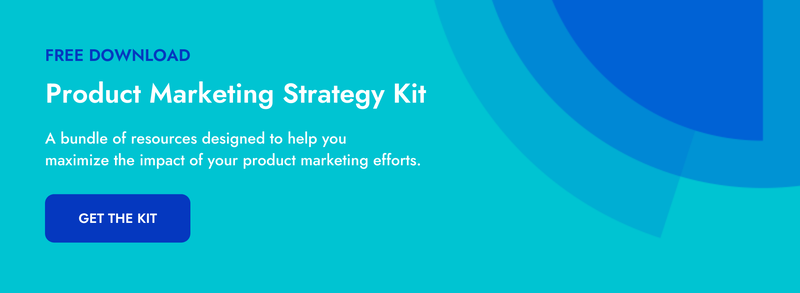Picture this: It’s Tuesday afternoon and yet another request just got added to your to-do list in Airtable. You take a look and immediately think to yourself, “There’s no way I can get to this. In fact, why does it even matter? They’re never going to use this asset anyway.”
If that sounds familiar to you, then allow me to make a recommendation: Take a page out of product management’s book, and instead of thinking about success as what can be achieved WITH you, think about success as what can be achieved WITHOUT you.
Just like product marketers, product managers sit in the nexus of a few different functions—in this case the user, engineering, and design/research teams. In order to make sure they are prioritizing the right things at the right time, they use frameworks to organize their work and help them lead with empathy to the problem that needs to be solved. One popular framework is the jobs to be done (JTBD) framework.
Elevate your product marketing strategy with this free kit >>
The idea is simple: If you think critically about the context of the request before taking action and get to the heart of what the requester is really trying to achieve (i.e., the job), you may uncover an additional unspoken need that can help both you and the requester save additional time.
For example, let’s imagine you got a request from a member of your sales team for a one-page leave-behind.
Without the JTBD framework, you will reference your messaging/positioning documentation to figure out what will best resonate with the customer. Your messaging house is built on a foundation of strong customer research, and once the one-pager is complete, you’ll feel confident you have solved the problem and saved the day.
But let’s put ourselves in the shoes of the person who made this request in the first place. As a sales rep who’s under pressure to make quota, you are often scrambling to find the information you need, and even when you do find it, you may not know when or how to bring it up, so it ultimately goes unused. It’s crunch time and you stick to what you know.
With the JTBD framework—to be clear, you’re back to being a PMM—you will first evaluate what the next step is after you deliver the requested collateral. You will think about what the rep is trying to accomplish with this one-pager and start to ask these questions to the rep before diving in. In this discovery, you may realize that the request was for a one-pager but the real need was a better understanding of the buying journey. The rep wanted a one-pager as "leave behind" material for the prospect to share with their VP, but in the buying journey, we learned that if we can engage the VP directly with our product team, then we have better results.
PMs often use the JTBD framework to make sure they understand the full customer workflow. Oftentimes, the spoken need is short-term/shortsighted and understanding the next step/what happens after the need can help you deliver even more value up-front. Using this framework as a PMM can be invaluable when you have more requests than you can ever possibly fulfill; it helps you stay ahead of future asks and make a dent in the never-ending list that is product marketing requests.

Seeing is believing! Check out Crayon for yourself.
Take a Product TourRelated Blog Posts
Popular Posts
-
 The 8 Free Market Research Tools and Resources You Need to Know
The 8 Free Market Research Tools and Resources You Need to Know
-
 6 Competitive Advantage Examples From the Real World
6 Competitive Advantage Examples From the Real World
-
 How to Create a Competitive Matrix (Step-by-Step Guide With Examples + Free Templates)
How to Create a Competitive Matrix (Step-by-Step Guide With Examples + Free Templates)
-
 24 Questions to Consider for Your Next SWOT Analysis
24 Questions to Consider for Your Next SWOT Analysis
-
 How to Measure Product Launch Success: 12 KPIs You Should Be Tracking
How to Measure Product Launch Success: 12 KPIs You Should Be Tracking



